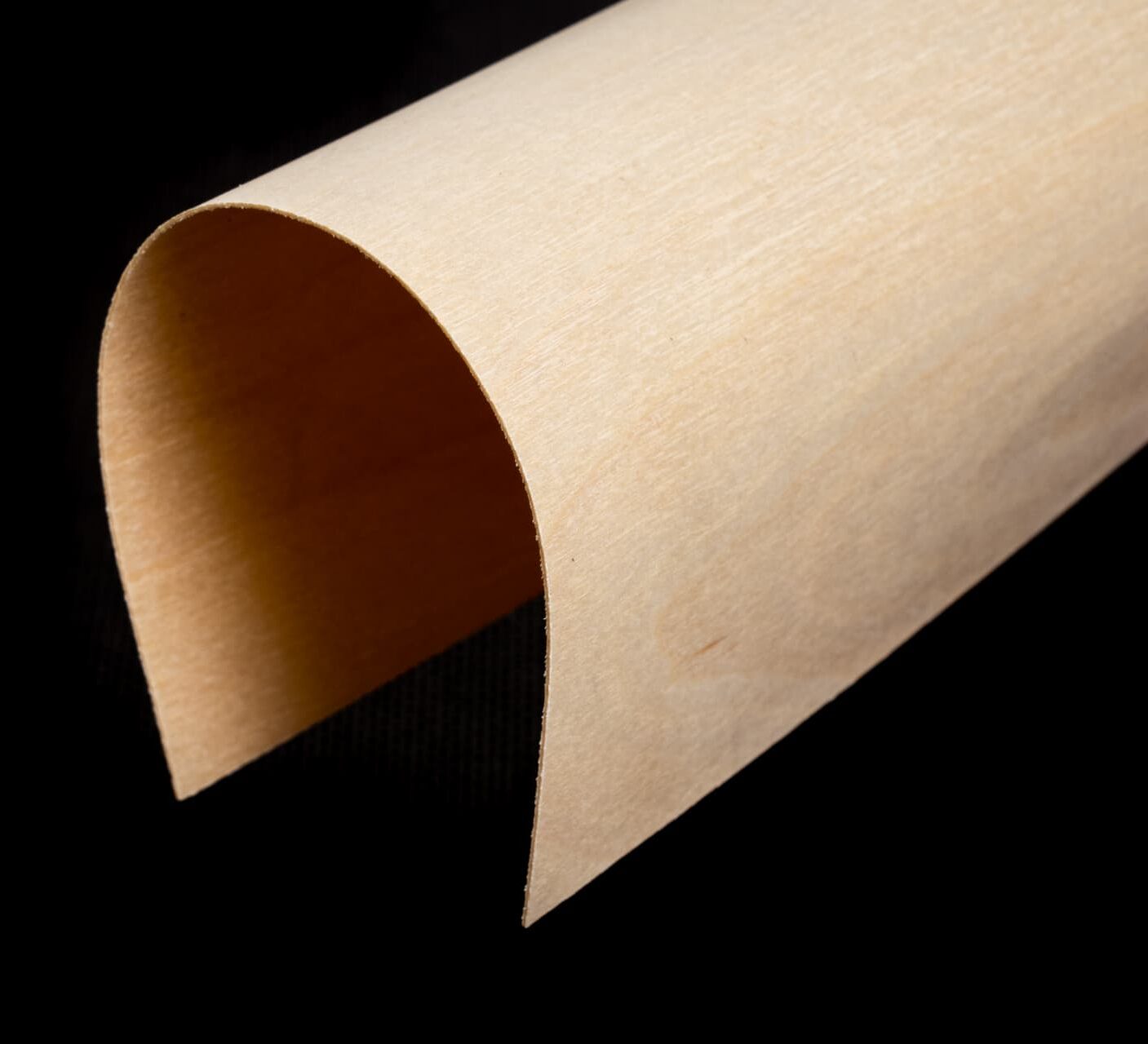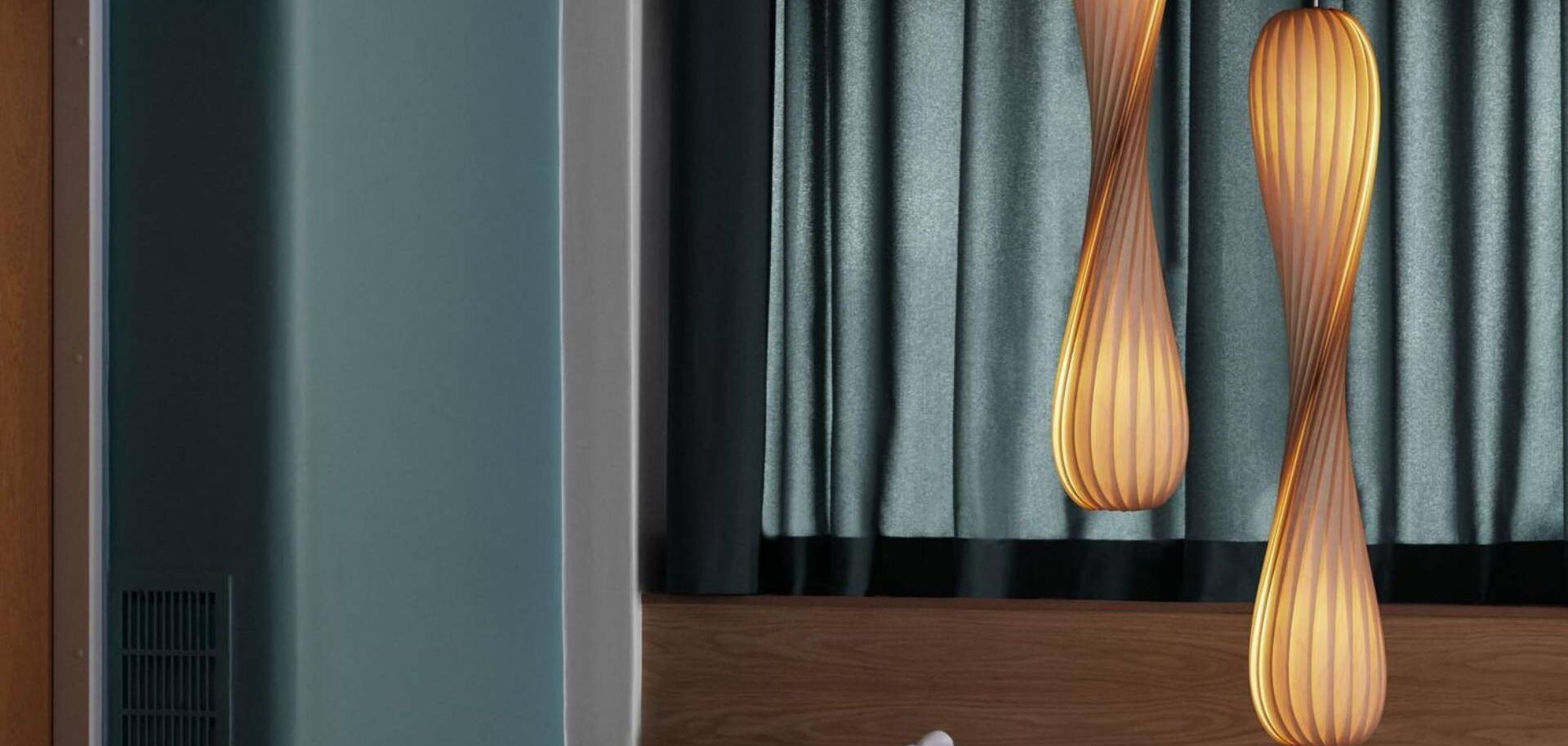Thin plywood as a material
Thin plywood differs from regular plywood in its structure. Thin plywood is manufactured from very high quality and thin layers of veneer. The veneer layers are cross-banded, meaning the grain direction varies between layers. These thin, high-quality birch veneers make it possible to produce exceptionally thin, flexible and strong plywood structures.
Thin plywood sheets are manufactured from renewable birch
Thinplywood - material for multiuse

-
Glue bond of thin plywood
The sheets sold in Koskisen’s online shop have been manufactured using Flex glue. Flex glue is elastic and light-coloured. The glue used in Koskisen’s thin plywood products that are sold in the online shop stays light when laser-cut. The elasticity of the glue helps control possible warping or bowing in the cut pieces. Koskisen sells thin plywood products made with other adhesives as factory deliveries to its customers and through its dealer network.
-
Nominal thickness and tolerance
We manufacture thin plywood from peeled veneer. The structure and nominal thickness of thin plywood sheets thus depends on the thickness of the core veneers. Thin plywood products are manufactured without tolerance sanding, which means that thicknesses can vary between batches. The thickness tolerance target for the sheets is ± 10% for plywood thicknesses under 3 mm and ± 5% for plywood thicknesses over 3 mm.
-
Surface and core veneers of thin plywood
The surface of all thin plywood products we supply is unsanded and untreated. In our hardwood products, the surface veneer sheets are sourced from our partners, and they have been either sliced or peeled, depending on the wood species.
Wood is a natural material and as a result, each piece of veneer is unique in appearance. The peeling of birch veneer guarantees a consistent, patch-free surface for our birch-faced thin plywoods. Peeling results a long continuous veneer sheet. After peeling, the veneers are graded. The best veneers are chosen for the surface, and the rest of the yield is used in the panels core structures. The core veneers of thin plywood may present random knots, knot holes, overlaps and small splits and checks.
-
Is thin plywood suitable for laser cutting?
All the thin plywood products available in our online shop have been bonded using light flex glue, which is suitable for laser cutting and leaves a light-coloured cut. We recommend the use of protective paper during laser cutting if you want a light-coloured cut. This will reduce the burn marks on the surface. Each device needs to be individually adjusted, so we recommend making a test piece and conducting your own tests to find the appropriate settings.
-
Surface treatment
The surface of the sheet can be left untreated, allowing the natural wood grain to show. The surface of all thin plywood products we supply is unsanded and untreated. The untreated surface is sensitive to dirt and colour changes due to UV exposure. You can also varnish, wax or stain the sheet just like any other wood surface.
The sheets should undergo a similar treatment on both sides to reduce potential warping due to moisture. Different varnishes, waxes, paints, stains and oils are perfectly suited for the surface treatment of thin plywood. To ensure the desired end result and the compatibility of the treatment product, we recommend testing the agent first on a sample piece or inconspicuous area.
The surfaces must be cleaned of dust, grease and dirt before treatment. Please familiarise yourself with the working methods and instructions of the surface treatment agent. Thin plywood’s smooth surface allows the use of a surface treatment agent even without a primer. The face veneer of thin plywood made from birch is approx. 0.5 mm, which allows for light sanding before treatment. The face veneer of our hardwood products may be slightly thicker.
-
Can products made from thin plywood be used outdoors?
The sheets are untreated, and they cannot be used outdoors without a protective treatment. Please see the section ‘Surface treatment’.
-
Origin of the wood raw material
Koskisen’s thin plywood is made from Finnish birch. We acquire the face veneers for our hardwood products (oak, cherry, teak, walnut) from our subcontractors. The veneers are made from certified wood raw materials. The birch veneers used in the production of Koskisen’s thin plywood are peeled from the most valuable, high-quality part of the special birch logs. Special birch log is the butt section of a mature birch, which has, for example, very few knots. After peeling, the veneers are graded. The best veneers are chosen for the face, and the rest of the yield is used in the sheet’s core structures.
-
Koskisen wood procurement
Sustainable wood sourcing is of primary importance to Koskinen. Responsible wood sourcing that promotes the diversity and vitality of forest nature today enables forest renewal and ensures that there is enough wood as raw material for future generations as well.
Koskisen uses a chain of custody system in all procurement to ensure that wood material is sourced legally and ethically from reliable and identified sources. The origin of all raw materials is always checked so that the forests in protected areas are safeguarded and wood is not sourced from controversial sources.
-
How can I recycle thin plywood waste?
We primarily recommend reusing the material. Consider whether you could use the leftover material from a small piece of furniture for some other purpose. Plan how you can use the material in a way that minimises waste, and think about how you can utilise any leftover material, including sawdust. Small amounts of thin plywood waste can be burned as energy waste along with other combustible material in suitable facilities. Please consult your local waste management provider’s instructions.
-
Thin Plywood Sheets Storage
The sheets must be stored horizontally in a well-ventilated space and protected from dirt and exposure to UV radiation. The storage conditions should correspond to the processing and use environment of the sheets due to humidity and temperature equalisation. Evenly distributed weight on top of the sheets helps the sheets to flatten out as straight as possible. Storing the sheets upright should be avoided. The sheets should be stored for a few days before working or machining to allow them to stabilise, for example, from variations in humidity during transport.
-
Face grades of thin plywood
The grades of the face veneers of thin plywood sheets are AB/B. This means that the grade category of the sheet’s face is AB and its reverse side is B.
In the AB grade, the natural characteristics of wood are allowed, such as slight colour variation, veins and small splits and checks or overlaps. Grain deviations and 2–3 knots with a maximum diameter of approx. 5 mm per sheet are also allowed.
B is a face grade that features the natural characteristics of birch. A slight colour variation, small splits and checks or overlaps, veins, a slight flame-like pattern and a few knots or knot holes with a maximum diameter of approx. 7–8 mm per sheet are allowed across the entire surface.
Thin plywood is manufactured from peeled, unpatched Finnish birch, and the veneer is characterised by the wood’s natural variations. Grading is performed on full-sized sheet blanks (1,220 mm x 1,220 mm), which means that pieces that are cut to smaller sizes may occasionally have more of the characteristics of birch veneer than the grade specification allows.





